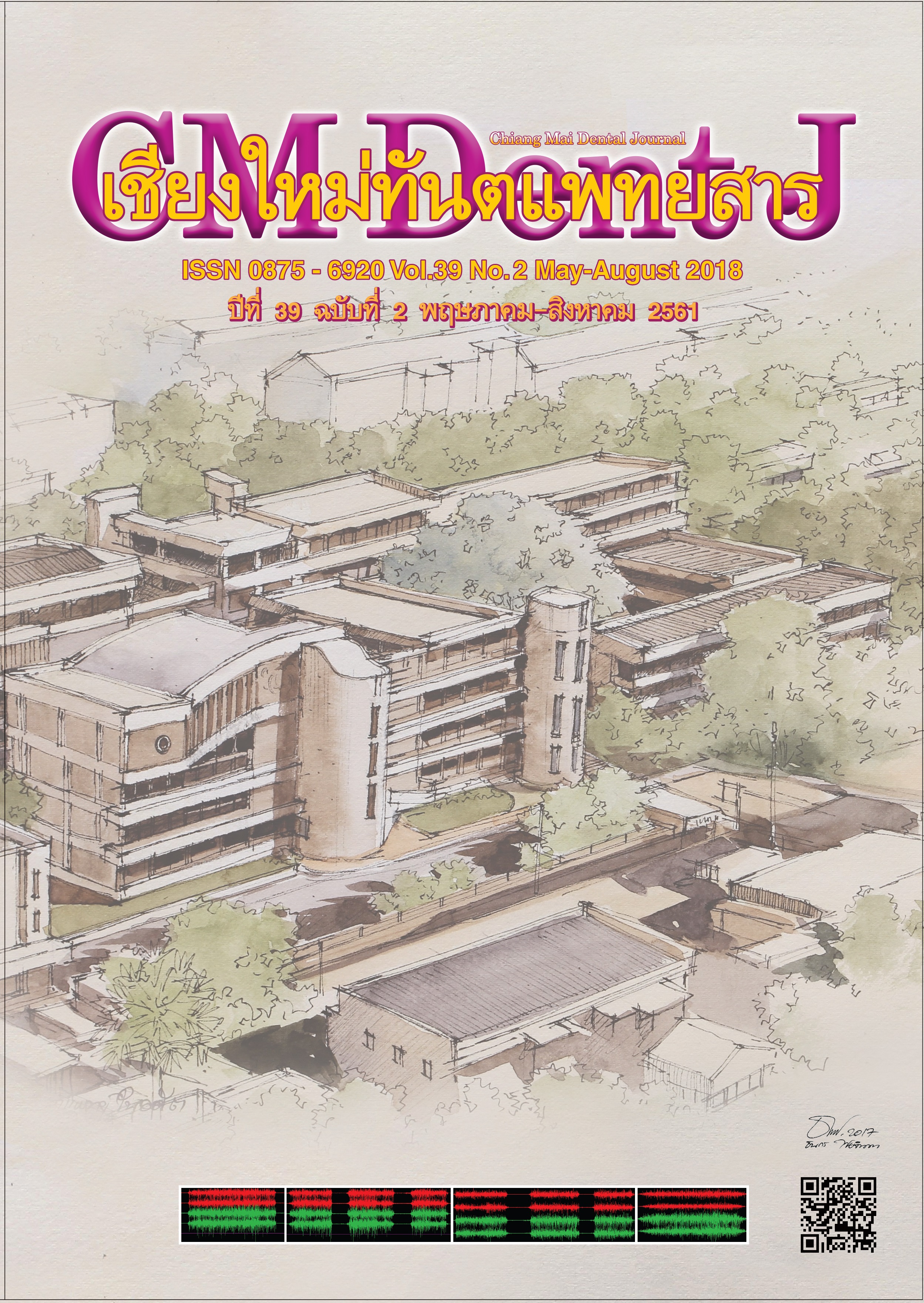Root Surface Areas of Maxillary Permanent Teeth in a Group of Thai Patients Exhibiting Anterior Open Bite Using Cone-Beam Computed Tomography
Main Article Content
Abstract
Objective: To assess the root surface areas of maxillary permanent teeth in a group of Thai patients exhibiting anterior open bite with open vertical configuration using cone-beam computed tomography (CBCT)
Materials and Methods: CBCT images of maxillary permanent teeth, categorized by tooth type (maxillary third molars were excluded) from 18 patients (age ranged from 15.0 to 30.0 years) were selected. Three-dimensional tooth models were constructed using Mimics Research 17.0 software. The cemento-enamel junction (CEJ) was marked. The root surface area was calculated automatically by 3-Matic Research 9.0 software. The means of root surface areas among tooth types were compared using the one-way analysis of variance (ANOVA) with multiple comparisons (p < 0.05).
Results: Means and standard deviations of root surface areas of maxillary permanent teeth were arranged in descending order as maxillary first molar (452.40±65.75 mm), maxillary second molar (379.85±79.71 mm), maxillary second premolar (245.52±44.03 mm), maxillary canine (244.80±54.11 mm2), maxillary first premolar (232.22±39.95 mm2), maxillary central incisor (182.70±27.80 mm2) and maxillary lateral incisor (163.29±24.42 mm2), respectively. Statistically significant differences among tooth types were found.
Conclusions: The root surface area measurement of maxillary permanent teeth, using CBCT measuring method, showed that the maxillary first molar had the greatest root surface area and the maxillary lateral incisor had the least.
Article Details
References
Hujoel P. A meta‐analysis of normal ranges for root surface areas of the permanent dentition. J Clin Periodontol 1994;21:225-229.
Gu Y, Tang Y, Zhu Q, Feng X. Measurement of root surface area of permanent teeth with root variations in a Chinese population-A micro-CT analysis. Arch Oral Biol 2016;63:75-81.
Dugal R, Gupta A, Musani S, Kheur M. Cone beam computed tomography: a review. Univ Res J Dent 2011;1:30.
Scarfe W, Farman A, Sukovic P. Clinical applications of cone-beam computed tomography in dental practice. J Can Dent Assoc 2006;72:75.
Tasanapanont J, Apisariyakul J, Wattanachai T, Sriwilas P, Midtbø M, Jotikasthira D. Comparison of 2 root surface area measurement methods: 3-dimensional laser scanning and cone-beam computed tomography. Imaging Sci Dent 2017;47:117-122.
Braun S, Bantleon H-P, Hnat WP, Freudenthaler JW, Marcotte MR, Johnson BE. A study of bite force, part 2: Relationship to various cephalometric measurements. Angle Orthod 1995;65:373-377.
Ingervall B, Minder C. Correlation between maximum bite force and facial morphology in children. Angle Orthod 1997;67:415-424.
Kay RF. The functional adaptations of primate molar teeth. Am J Phys Anthropol 1975;43:195-215.
Watt D, MacGregor A, Geddes M, Cockburn A, Boyd J. A preliminary investigation of the support of partial dentures and its relationship to vertical loads. J Contemp Dent Pract 1958;9:2-15.
Tylman SD. Theory and practice of crown and bridge prosthodontics. St. Louis: C.V. Mosby Company; 1960.
Jepsen A. Root surface measurement and a method for x-ray determination of root surface area. Acta Odontol Scand 1963;21:35-46.
Enokida M, Kaneko S, Yanagishita M, Soma K. Influence of occlusal stimuli on the remodelling of alveolar bone in a rat hypofunction-recovery model. J Oral Biosci 2005;47:321-334.
Hayashi Y, Iida J, Warita H, Soma K. Effects of occlusal hypofunction on the microvasculature and endothelin expression in the periodontal ligaments of rat molars. Orthod Waves 2001;60:373-380.
Tanaka A, Iida J, Soma K. Effect of hypofunction on the microvasculature in the periodontal ligament of the rat molar. Orthod Waves 1998;57:180-188.
Shimomoto Y, Chung C, Iwasaki-Hayashi Y, Muramoto T, Soma K. Effects of occlusal stimuli on alveolar/jaw bone formation. J Dent Res 2007;86:47-51.
Karavade R, Kalia A, Nene S, Khandekar S, Patil V. Comparison of root-crown lengths and occlusal contacts in patients with class-III skeletal relationship, anterior open-bite and high mandibular plane angle. Int J Dent Med Spec 2015;2:7.
Uehara S, Maeda A, Tomonari H, Miyawaki S. Relationships between the root-crown ratio and the loss of occlusal contact and high mandibular plane angle in patients with open bite. Angle Orthod 2012;83:36-42.
De Freitas MR, Beltrão RTS, Janson G, Henriques JFC, Cançado RH. Long-term stability of anterior open bite extraction treatment in the permanent dentition. Am J Orthod Dentofacial Orthop 2004;125:78-87.
Harris EF, Butler ML. Patterns of incisor root resorption before and after orthodontic correction in cases with anterior open bites. Am J Orthod Dentofacial Orthop 1992;101:112-119.


